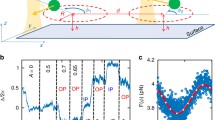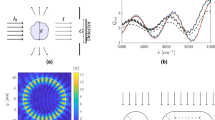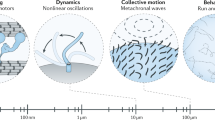Abstract
A model of a freely rotating exended scatterer is proposed to describe light scattering from beating cilia. Gaussian rotation frequency distributions, characterized by a mean angular frequency and a standard deviation, are introduced in order to simulate intensity autocorrelation functions and to fit the model to experimental data. Thus the ciliary beats are characterized by a mean beat frequency and a standard deviation of the beat frequency distribution. The standard deviation influences the damping of the intensity autocorrelation function of light scattered from cilia. The calculated intensity autocorrelation function shows a more prominent oscillating behaviour the smaller the standard deviation of the beat frequency. The validity of the model is supported by experimental data in two ways: 1) The model fits very well to experimental data in computer evaluations, 2) Neither the model nor information obtained from measurements are dependent on the measuring angle.
Similar content being viewed by others
References
Berne BJ, Pecora R (1976) Dynamic light scattering with applications to chemistry, biology, and physics. Wiley, New York
Bonnaire Y, Debreuil A, Bouley G, Boudène C (1980) An improved device for frequency recording of tracheal ciliary beat. Microsc Acta 83:221–227
Dahlhamn T (1962) Frequency of ciliary beat measured with a photo-sensitive cell. Nature (London) 196:592–593
Eshel D, Priel Z (1986) Spectral characterization of ciliary beating: Biological meaning of the spectral linewidth. Biophys Chem 23:261–265
Eshel D, Priel Z (1986) Spectral characterization of ciliary beating: Temperature dependence of spectral parameters. Biophys Chem 25:215–222
Eshel D, Grossman Y, Priel Z (1985) Spectral characterization of ciliary beating: Variations of frequency in time. Am J Physiol 249: C160-C165
Håkansson CH, Toremalm NG (1965) Studies on the physiology of trachea. I. Ciliary activity indirectly recorded by a new “light beam beam reflex” method. Ann Otol Rhinol Laryngol (Stockh) 74:118
Hennesey SH, Wong LB, Yeates DB, Miller IF (1986) Automated measurements of ciliary beat frequency. J Appl Physiol 60: 2109–2113
Kennedy JR, Duckett KE (1981) The study of ciliary frequencies with an optical spectrum analysis system. Exp Cell Res 135:147–156
Lee WI, Verdugo P (1976) Laser light spectroscopy: A new application in the study of ciliary activity. Biophys J 16:1115–1119
Lee WI, Verdugo P (1977) Ciliary activity by laser light-scattering spectroscopy. Ann Biomed Eng 5:248–249
Marquardt DW (1963) An algorithm for least-squares estimation of nonlinear parameters. J Soc Indust Appl Math 11:431–441
Rigler R, Thyberg P (1984) Rotational and translational swimming of human spermatozoa: A dynamic laser light scattering study. Cytometry 5:327–332
Sleigh MA, Blake JR, Liron N (1988) The propulsion of mucus by cilia. Am Rev Respirat Dis 137:726–741
Spungin B, Silberberg A (1984) Stimulation of mucus secretion, ciliary activity in frog palete epithelium. Am J Physiol 247 (Cell Physiol 16):C299-C308
Svartengren K, Wiman L-G, Thyberg P, Rigler R (1989) Laser light scattering spectroscopy. A new method to measure tracheobronchial mucociliary activity. Thorax 44: 539–547
Verdugo P, Johnson NT, Tam PY (1980) β-Adrenergic stimulation of respiratory ciliary activity. J Appl Physiol: Respirat Environ Exercise Physiol 48:868–871
Yager J, Chen T-M, Dulfano MJ (1978) Measurements of frequency of ciliary beats of human respiratory epithelium. Chest 73:627–633
Author information
Authors and Affiliations
Additional information
The contents were presented in part at the 9th International Biophysics Congress in Jerusalem, Israel, August 23–28, 1987
Offprint requests to: P. Thyberg
Rights and permissions
About this article
Cite this article
Thyberg, P., Rigler, R., Svartengren, K. et al. Biophysical models of ciliary activity: Gaussian frequency distributions. Eur Biophys J 18, 85–91 (1990). https://doi.org/10.1007/BF00183267
Received:
Accepted:
Issue Date:
DOI: https://doi.org/10.1007/BF00183267




